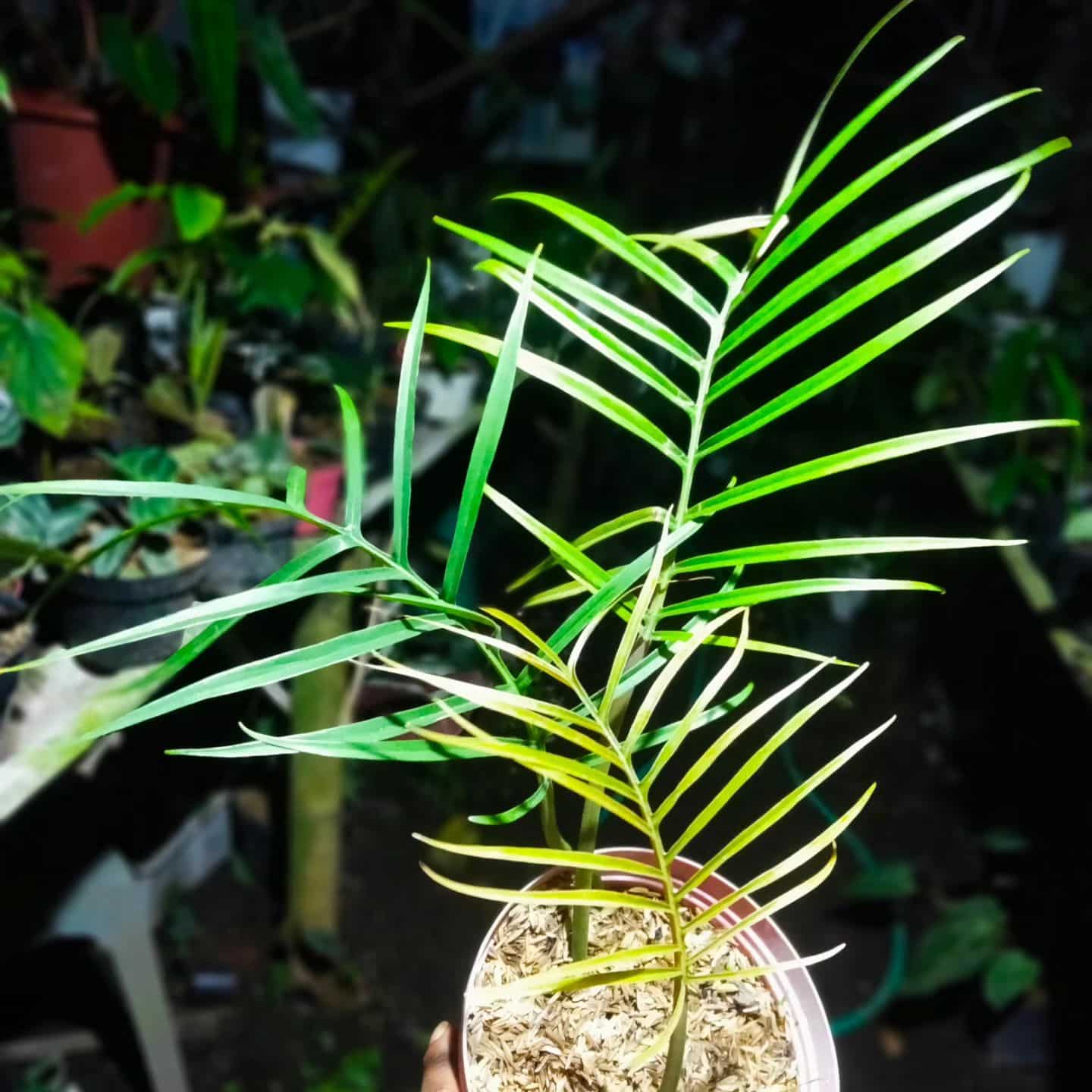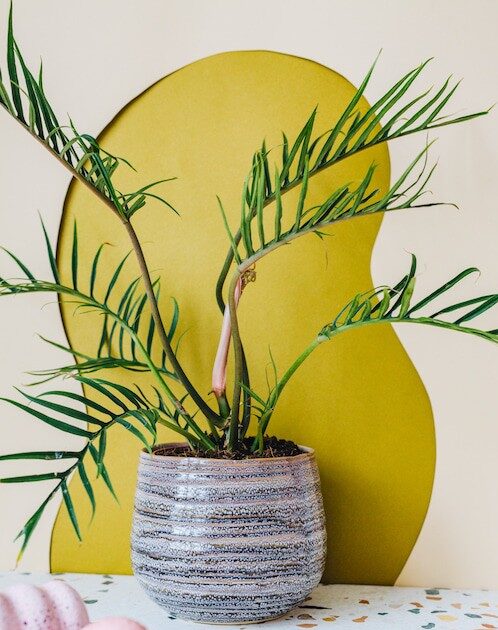Philodendron bipinnatifidum tortum, another name for Philodendron tortum, is one of the rarest species in its family.
It belongs to the Arum family and is an evergreen plant.
The Philodendron tortum, often known as the “tree-loving,” is a low-maintenance, easy-to-care-for plant.
So let’s dive into the article to learn more about this unique species of Philodendron!
Table of Contents
Overview of Philodendron Tortum
Let’s have a look at a quick overview of the plant.
| Indicator | Identity |
|---|---|
| Scientific Name | Philodendron Bipinattifidum |
| Native | Brazil |
| USDA | Zone 10a-11 |
| Nature | Tropical |
| Average Height | Up to 6 meters |
| Space | 1-1.5 inches |
| Toxicity | Toxic to cats and dogs |
| Light Requirement | Medium, Indirect Light for 6 hours 2-3 Hours of Direct Morning Light |
| Temperature | Between 59 and 86 degrees Fahrenheit |
| Watering | 1/2 times a week in Summer Water Sparingly in Winter |
| Humidity | 60-80 Percent |
| Soil Type | Wet, Well-draining, Organic-rich with a pH value between 5-7 |
| Fertilization Requirement | Once a week in Growing Season 7-9-5 N-P-K fertilizer |
| Pruning Requirement | Occasional Pruning |
| Repotting | Early Spring 1-2 inches larger than the root ball |
| Pot | Glazed ceramic pot, Plastic pot, or Hanging basket |
| Propagation | Stem-Cutting Air-Layering |
| Pests/Diseases | Aphids, Mealy bugs, Spider mites, Erwinia Blight Disease |
| Blooms | Non-Flowering Plant |
| Foliage | Green in hue and have a glossy, smooth feel |
Where to Buy Philodendron Tortum?
Although Philodendron tortum is considered a rare aroid, there are various platforms where you can buy and add this rare plant to their green collection.
Below is a list of shops that I’ve found for you to grab this rare gem:
| Places to Buy | Delivery Service |
|---|---|
| Amazon | 3-6 days |
| Tropics @Home | 10-14 days |
| Happy Houseplants | 7-10 days |
Plant Guide and Care Tips for Philodendron Tortum
As Philodendron tortum is a low-maintenance plant, it is ideal for beginners.
Similarly, these plants don’t require much work to stay alive; virtually anyone can care for them and maintain them alive.

All home plant fans adore it because of its low-maintenance qualities.
Let’s quickly look at the user guide and care tips for Philodendron tortum!
1. Sunlight and Temperature
For optimal results, position your Philodendron tortum in a location that receives medium, indirect light.
The Philodendron tortum enjoys light and airy environments. As a result, the location in which they are housed is crucial.
Do not place it in a sunny location, as the leaves may burn and develop brown spots.
If direct sunlight is intense for several hours, the damage can be irreversible, and the leaves of the Tortum can be burned.
Proper Light & Temperature Maintaining Tips
- Use shade curtains during high-light and high-temperature months.
- Keep an LED grow light or, for a less expensive option, a full-spectrum light bulb inserted into a nearby lamp to keep the leaves healthy.
- 2-3 Hours of the direct morning Sun is best for the plant.
- Turn the pot regularly for the even growth of the stem towards the light source.
- Similarly, ensure your plants aren’t in the same fire hazard as fireplaces, radiators, ovens, and other heat sources.
- A Frost blanket can be used as a cover for your plant to prevent cold.
2. Watering & Humidity
The Philodendron tortum prefers wet, well-drained soil, emphasizing the latter- only enough water to keep the top inch (3cm) of soil moist.
The plants show yellowing, stunting, and rotting symptoms when exposed to overwatering.
In contrast, the underwatering symptoms are wilting, drying, and browning.
Tips for Proper Watering & Humidity
- Make a proper watering schedule so you wouldn’t forget to water your tortum.
- To enhance drainage, temporarily cease watering your plant.
- Water when the top 2 inches of the soil is dry.
- Group your plants to boost the humidity in your home to benefit your Philodendron tortum.
- Misting is another simple method to raise humidity.
3. Soil & Fertilizers
The pH of the soil should be between 5-7 with a wet, well-draining, organic-rich aroid potting mix.
The potting mix is the cornerstone for your plant’s existence, and the key to getting it proportionate is balancing the quantity of moisture-retaining and moisture-draining ingredients.

Similarly, Perlite and orchid bark help with drainage (and allow roots to establish attachments).
In addition, We propose using Dyna-Gro, which is a 7-9-5 NPK formula. This fertilizer gives your plant all the 16 nutrients required to thrive.
- Activated Charcoal is supposed to keep pests at bay, eliminate pollutants from the soil, and prevent mold growth.
- Throughout the summer and spring, you may dilute a quarter teaspoon of Dyna-Gro in a gallon of water and use it to water your plant once a week.
- Worm castings (sometimes known as worm excrement) are organic fertilizers.
- Kelp and seaweed extract, worm tea, and compost tea are all-natural fertilizers to consider.
4. Pruning Requirements
As previously noted, the Philodendron Tortum is a fast-growing plant with evergreen features.
If the plant’s leaves begin to overflow or take up too much space, you must clip them occasionally.
Trimming the plant gives it a cleaner and more well-groomed appearance.
Pruning the Tortum is recommended after dormancy in the early spring.
Things to keep in mind before pruning
- Know when it’s time to prune. Pruning should not be done in the late summer or fall.
- Know where to make your cuts. Always cut down to the soil line or just above a developing point (branch or bud).
- Never leave a stub of a stem or branch.
- Thirdly, also get rid of any troublesome branches.
- Likewise, dense growth should be thinned down. You may increase the general health of your plant by thinning down thick growth and allowing more light, rain, and air to penetrate.
- In addition, prune your plant frequently. During pruning, you should just remove 30% of the plant.
5. Potting and Repotting
Use big pots from the start to avoid the need for regular Repotting.
If you’ve planted your Philodendron in a tiny container, however, repotting is necessary because this plant grows swiftly.
Philodendron tortum is a quick grower; you should always watch out for the roots.
If the roots are growing out of the pot, it is clearly a sign that your tortum needs transplanted into a bigger pot.
Philodendron tortum should be repotted in the early spring once the plant has emerged from dormancy.
Here is a step-by-step method to repot your Tortum:
- First, remove the Philodendron tortum from its former pot and remove any extra soil from the roots.
- Choose a glazed ceramic pot, plastic pot, or hanging basket with a 1-2 inches diameter greater than your plant’s root ball.
- Then, carefully put your Philodendron into the new suitable pot.
- Finally, continue watering and fertilizing, as mentioned above.
Growth Habits
While indoors, individual leaves (the sword-like branches) may grow up to 2-3 inches (5-8cm) in length, and the Philodendron tortum can grow up to 6 feet tall (1.8m).
Similarly, they may grow up to 19 feet tall in the wild, dwarfing their youthful form (6m).

Philodendron tortum may reach a height of around 6 meters. They have skeleton-like leaves that are narrow and thin.
The leaves are green in hue and have a glossy, smooth feel. The leaves are long and thin, with roughly 1-1.5 inch gaps between them.
Similarly, tortum is an evergreen plant. The term “evergreen” refers to plants that remain green throughout the year for as long as they live.
Seasonal changes do not influence the plant’s form, growth, or color.
Propagation Methods
When you have a mature Philodendron tortum, you won’t need to acquire another one unless you want more of the same plant.
The stem cuttings or air-layering are simple ways to cultivate the Philodendron tortum.
Similarly, to improve your chances of growing Philodendron tortum successfully after propagation, start the procedure in the early spring when your plant’s growth cycle begins.
Stem Cutting Method
- Cut the stem just below the nodes using a clean pair of pruning scissors.
- Make a tiny container with damp sphagnum moss and Perlite (50-50).
- Dip the newly cut stem/aerial roots into a rooting hormone powder or solution.
- Plant the stem in your ready-to-use potting soil (2-3 inches into the mix).
- Then, fill the pot with the sphagnum moss and perlite mixture.
- Place in a warm place with plenty of indirect light.
- Make sure the moss is maintained wet by watering it.
Note: The tortum tends to establish roots fast. Within 2-3 weeks, you should start to see some roots emerge.
You may transplant it to a larger container with a richer potting mix after the roots are roughly 1 inch (3cm) long.
Air-Layering Method
The air layering approach is effective for mature, well-established Philodendron tortum that are already crawling up a pole or stake.
- Look for some older, well-established aerial roots emerging from a strong node.
- Wrap some damp sphagnum moss over the healthy node, including the roots and pole—this aids in supporting thinner stems.
- Wrap moss completely around the node with a clear plastic bag or press-and-seal food wrap. However, be careful you don’t get any leaves caught in this wrap.
- Leave the seal’s top and bottom open because new roots like to descend, allowing them to do so without bunching.
- Spray the sphagnum moss well via the open-top in the plastic bag daily. Spraying prevents the moss from drying out and compacting.
- Allow two to three weeks for new roots to emerge.
- Care, remove the plastic wrap and some moss around your new roots. Be sure the roots are in good shape!
- Using clean scissors to cut the stem immediately below the new roots would be best.
- In a thick potting mix, place the stem (see above). Then, as usual, take care of it.
Toxicity of Philodendron tortum
When consumed, the sap of Philodendron tortum includes calcium oxalate crystals, rendering the plant poisonous.
When you come into contact with a component of the plant, these particles irritate your skin.
According to ASPCA, Philodendron tortum is toxic to both dogs and cats.
As a result, be sure to keep your plant out of the reach of youngsters and pets.
To guarantee that access to the plant is managed, more restricted locations, such as bedrooms, are more suited.
You immediately need to consult a local veteran or Call the APCC at (888) 426-4435 for pets.
Frequently Asked Questions
Why does my Philodendron tortum have Yellow Leaves?
Yellowing leaves can be caused by various factors, including magnesium shortage and pests, but the most common reason is root rot caused by overwatering.
Why does my Philodendron Tortum have Brown Patches on Leaves?
Brown areas indicate that your plant has been exposed to direct sunlight for an extended period.
A few hours are acceptable, but an entire day is not. Scorch markings are brown spots.
Does the Philodendron Tortum Climb?
The Philodendron tortum is a climbing plant that will benefit from a pole or stake to keep it upright.
A pole can support the tree’s limbs to become thicker, keeping the tree from drooping.
From Editorial Team
Conclusion!
Finally, Philodendron tortum plants are the greatest choice for everyone who wants to begin maintaining plants in their homes.
The plant is ideal for beginners since it requires little maintenance and can be kept alive with little effort.
In addition, it offers a touch of freshness to whatever location it’s kept in and has lovely leaves that drape the floor or anything else it’s placed on.


